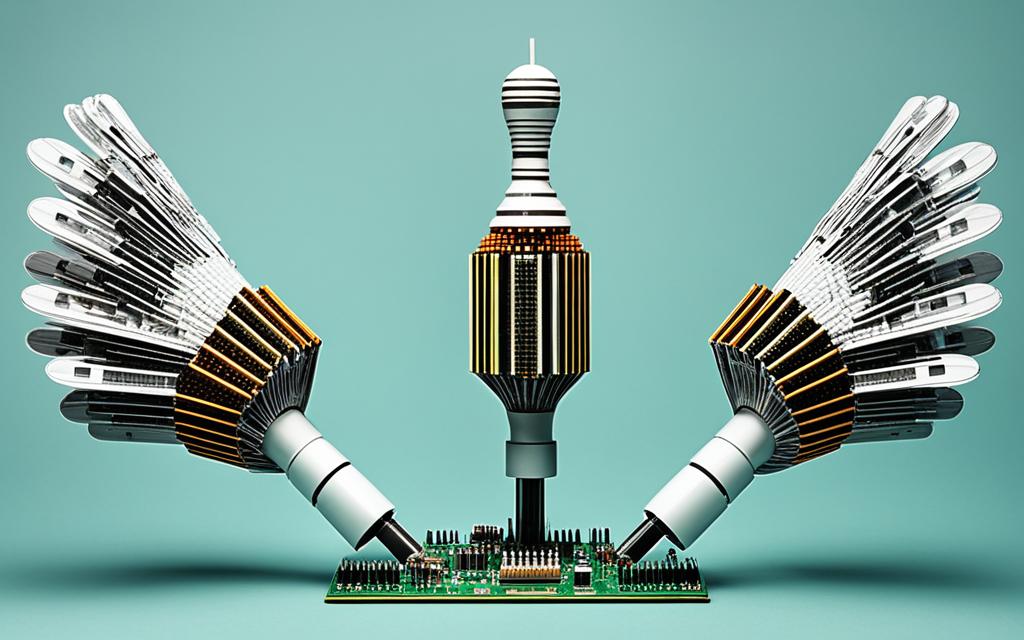“Shuttlecock” has no meaning in computer terms. It’s a term that’s not connected to technology or computing. Instead, “shuttlecock” is a key term in badminton. It describes a high-drag projectile used in the game.
In badminton, the shuttlecock is central to the game. Players use it for serving and playing. It’s designed for great aerodynamics, allowing it to move well across the court. This design combines unique construction and materials for better flight and durability.
Understanding “shuttlecock” in computing is less necessary than knowing it in badminton. The sport depends on this special projectile. It makes the game engaging and challenging for everyone playing.
Key Takeaways
- 1. “Shuttlecock” means nothing in computer language1.
- 2. It’s a crucial term in badminton, describing a specific game piece1.
- 3. Shuttlecocks are made for the game, with aerodynamic features1.
- 4. They have a specific build and materials for good flight and lasting use2.
- 5. Knowing about shuttlecocks is key for badminton players2.
Origins and Specifications of a Shuttlecock
The name “shuttlecock” comes from its movement in badminton, similar to a loom’s shuttle in the 14th century. It first appeared in Asia, in countries like China, India, and Thailand3. By the 1500s, “shuttlecock” was officially recorded. Now, the Badminton World Federation (BWF) uses it to call the sport’s projectile3.
A standard shuttlecock has feathers from geese or ducks, forming a skirt, and weighs between 4.75 and 5.50 g4. The 62 to 70 mm long feathers help it fly steadily and play well4. The cork part is 25 to 28 mm wide, giving it the right balance and weight4.
Shuttlecock specs are key for good play. They let players hit accurately and enjoy long rallies. Over time, these designs have changed to keep the game fun for everyone4.
Different places call shuttlecocks by various names like “birdie,” “shuttle,” and “shuttleball”4. Each name shows something special about its lightness, flight, or size.
The design and names of shuttlecocks tell us about the history and growth of badminton. They ensure the game keeps a high standard and remains enjoyable worldwide.
Construction and Materials of a Shuttlecock
A shuttlecock is key in badminton, affecting how the game is played. Knowing what it’s made of helps us understand how it moves and performs during a game.
At its core, a shuttlecock has a round cork base fitted with 16 feathers. These feathers come from either geese or ducks. This practice has raised concerns among those who care about animal welfare. The cork is then wrapped in a thin layer of leather. This boosts how well the shuttlecock flies. Some makers use polyurethane or natural cork for the base, enhancing durability2.
A standard shuttlecock’s weight is set between 4.75 to 5.50 grams. Each of its feathers is 62 to 70 mm long. This design helps with its shape and stability. The cork’s diameter is about 25 to 28 mm. Plus, the feathers form a circle measuring 58 to 68 mm across. These specs ensure shuttlecocks are consistent and meet the required standards2.
Choosing the right materials is vital in making shuttlecocks. Feather shuttlecocks, crafted from natural feathers, are preferred in professional matches. They offer superb flight but must be humidified before use to last longer and fly correctly2.
On the flip side, synthetic shuttlecocks are made to last. They withstand multiple games without losing their flight quality. While their flight is more consistent, their speed range is lower. This can change the gameplay feel2.
“The construction of a shuttlecock, with its feathers delicately arranged around a cork base, showcases the intricate craftsmanship and engineering required to create a remarkable sporting projectile.”
~ Badminton Equipment Specialist
Comparison of Feathered and Synthetic Shuttlecocks
Feathered shuttlecocks, with their distinct flight characteristics, are sought after for competitive games. They provide consistent flight and a higher speed, enriching player experience2.
Synthetic shuttlecocks, however, offer a sturdy alternative. They don’t need replacing as often, making them cost-effective. Their consistent flight pattern allows players to practice and improve their technique2.
Recently, there’s talk of making shuttlecocks from synthetic feathers. This could make them last longer and cut down costs. It’s a promising idea for both casual and professional players5.
Exploring Shuttlecock Materials and String Tensions
The choice of feather type affects a shuttlecock’s performance, but so does the racquet string type and tension. Different materials like Kevlar or polyester have been tested to see how they influence the game6.
High string tension can slow the shuttlecock, while low tension increases its speed. This choice can shape a player’s game style and strategy6.
String thickness also affects its elasticity. Thicker strings are less elastic. Players should consider both durability and playability when choosing their strings6.
A study found that only 27% of players could tell the difference in string performance with hearing protection. This suggests that skill and technique are also crucial6.
In summary, a shuttlecock’s build and the materials used significantly shape its flight and game performance. There is a variety to suit every player’s style, whether they prefer feathered or synthetic. Innovations continue to improve the game for everyone around the globe2.
| Shuttlecock Properties | Feather Shuttlecocks | Synthetic Shuttlecocks |
|---|---|---|
| Weight (g) | 4.75 to 5.50 | N/A |
| Feather Length (mm) | 62 to 70 | N/A |
| Cork Diameter (mm) | 25 to 28 | N/A |
| Diameter of Feathers Circle (mm) | 58 to 68 | N/A |
| Material | Natural feathers | Synthetic materials |
| Durability | Requires proper humidification and care | Lasts many matches without impairment to flight |
| Flight Consistency | Consistent drag coefficient | More consistent flight properties |
| Standard Speed Range | Higher range | Lower range |
Feathered vs. Synthetic Shuttlecocks
Choosing between feathered and synthetic shuttlecocks can be tough for badminton players. Each type brings different benefits to the game. They match various playing styles and preferences.
Feathered shuttlecocks are the top pick for skilled players. They perform exceptionally well and fly smoothly. According to studies, they stabilize in flight quicker than synthetic types, showing better stability and uniformity7. Feathered ones also keep stable during fast flips. They maintain a steady drag, making them ideal for professional matches where accuracy is key.
Synthetic shuttlecocks, on the other hand, are known for their toughness. They don’t need special care before the game and withstand multiple matches without losing performance2. Although they don’t match feathered shuttlecocks in speed, they still offer a distinct play experience2. Their flight differs due to unique fluid force coefficient curves7.
The choice between feathered and synthetic shuttlecocks depends on personal taste and the game’s demands. Feathered shuttlecocks deliver top performance and flight. Synthetic shuttlecocks are great for long-lasting play and convenience. Players should weigh these aspects to find the best fit for their style. Enhance your badminton play by making an informed choice [source] [source] [source].
FAQ
Is there any connection between the term “shuttlecock” and computer terminology?
No, there’s no link between “shuttlecock” and computer terms. It’s actually about a projectile used in badminton.
Where does the term “shuttlecock” come from?
“Shuttlecock” is named after its movement in badminton. It moves like the shuttle in an old loom.
What are the specifications of a regulation standard shuttlecock?
A standard shuttlecock’s feathers weigh about 4.75 to 5.50 g. They are 62 to 70 mm long. The cork’s diameter is 25 to 28 mm, which helps it fly well and makes the game enjoyable.
How is a shuttlecock constructed?
Shuttlecocks have about 16 feathers, from geese or ducks, fitted into a cork base. This base is then covered in leather to help it fly properly.
What materials are used in shuttlecock construction?
Shuttlecocks are made using feathers from bird wings, a detail animal lovers sometimes challenge. Manufacturers also use polyurethane or durable natural cork for the base.
What are the differences between feathered and synthetic shuttlecocks?
Pros often prefer feathered shuttlecocks for their better speed and stable flight. Synthetic ones, called “plastics,” last longer. They don’t need to be moistened before use and fly differently.
Source Links
- https://gamerant.com/new-york-times-connections-250-february-16-2024-hints-answers/ – New York Times Connections Hints and Answers for #250 February 16, 2024
- https://en.wikipedia.org/wiki/Shuttlecock – Shuttlecock
- https://badmintonbites.com/where-does-shuttlecock-get-its-name-from/ – Where Does Shuttlecock Get Its Name From? – BadmintonBites
- https://medium.com/@howardmitchell1921/unraveling-the-mystery-what-is-a-badminton-ball-called-b76079d80860 – Unraveling the Mystery: What is a Badminton Ball Called?
- https://www.mdpi.com/2504-3900/2/6/267 – The Behavior of Badminton Shuttlecocks from an Engineering Point of View
- https://www.ncbi.nlm.nih.gov/pmc/articles/PMC10346262/ – Experimental and Computer Simulation Studies on Badminton Racquet Strings
- https://www.mdpi.com/2504-3900/49/1/104 – Comparison of Aerodynamic Properties of Badminton Feather and Synthetic Shuttlecocks


















